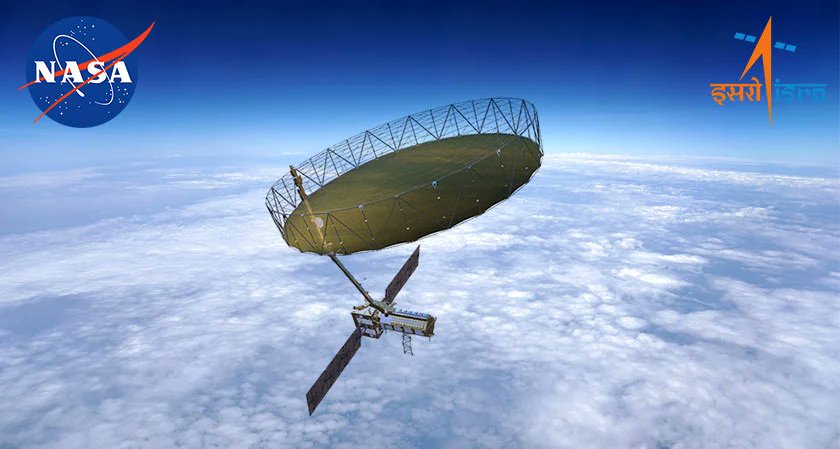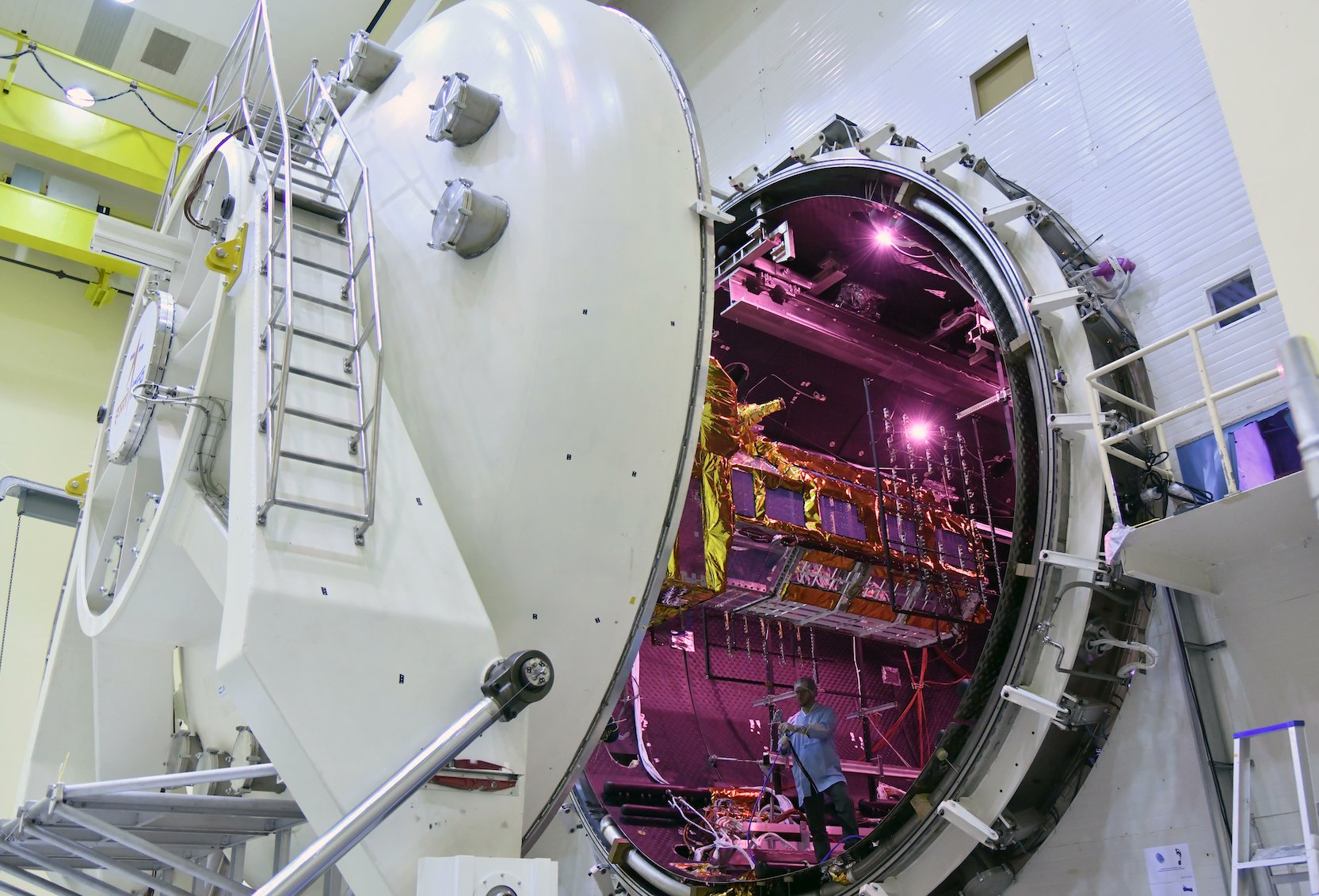Introduction to ISRO & NASA’s Combined New Project NISHAR
Overview of ISRO and NASA’s History of Collaboration :
In a groundbreaking partnership, the Indian Space Research Organisation (ISRO) and the National Aeronautics and Space Administration (NASA) have teamed up on an ambitious Earth observation mission called NISAR (NASA-ISRO Synthetic Aperture Radar). This joint mission aims to deploy a cutting-edge satellite that will revolutionize how we monitor and understand the Earth’s environment.
This will be the first mission to use both NASA’s advanced radar technology and ISRO’s proven satellite systems to monitor various global phenomena. The mission’s focus includes studying Earth’s surface, including its forests, glaciers, and earthquake zones, with the goal of improving disaster preparedness and environmental monitoring. With this project, the collaboration between these two space giants will significantly enhance our ability to respond to climate change, natural disasters, and more.
What is the NISAR Project?
Overview : Purpose and Objectives
The NISAR mission is a global Earth observation project jointly developed by ISRO and NASA. The primary goal of the mission is to provide a detailed, real-time view of the Earth’s surface. Using synthetic aperture radar (SAR) technology, that will capture high-resolution images of the Earth, allowing scientists to monitor changes in the environment, natural disasters, and even detect subtle movements in Earth’s crust.
The data gathered by NISAR will support efforts to understand and mitigate the impacts of climate change, enhance disaster management, and contribute to better agricultural and water resource management. With its ability to observe the planet in any weather condition, day or night, this will offer an unprecedented ability to track the Earth’s changes over time.
NASA and @ISRO‘s NISAR mission, set to launch in early 2025, will help us understand changes in Earth’s surface, including phenomena such as quakes, volcanoes and landslides.
Here’s how NISAR could help us prepare for, and recover from, future disasters: https://t.co/ShNvkJjlgC pic.twitter.com/Q8tmRjzjMO
— NASA (@NASA) November 8, 2024
Key Objectives of the NISAR Mission
- Monitor Earth’s Changing Climate: One of the key missions of this project is to observe the impacts of climate change on Earth’s surface, including melting glaciers, deforestation, and rising sea levels.
- Natural Disaster Management: This will be instrumental in tracking natural disasters like earthquakes, tsunamis, and volcanic eruptions, helping governments respond quickly and efficiently.
3. Improve Agricultural Practices: The radar technology used by NISAR can be used to monitor crop health, soil moisture, and changes in vegetation, providing farmers with valuable insights into optimizing agricultural productivity.
Technology Behind the NISAR Mission
Synthetic Aperture Radar (SAR) Technology
At the heart of the this project is Synthetic Aperture Radar (SAR) technology. This radar system is capable of capturing high-resolution images of the Earth’s surface by emitting radio waves and measuring the echoes that return. The information gathered can then be used to create detailed, three-dimensional maps of the Earth’s terrain. Unlike optical imagery, SAR can see through clouds, smoke, and darkness, which makes it incredibly useful for continuous monitoring in any weather condition.
The SAR system aboard the NISAR satellite will be the most advanced of its kind, with the ability to capture very fine details of Earth’s surface, down to a few meters in resolution.
ISRO’s Role in this Mission
ISRO is responsible for developing and launching the NISAR satellite. The agency will provide the spacecraft platform, launch vehicle, and overall mission operations. With years of experience in space missions, ISRO has a proven track record of successfully designing and deploying satellites for Earth observation, making it the perfect partner for this ambitious project.
The launch vehicle for this satellite will be ISRO’s GSLV Mk II, which will carry the satellite into orbit. Once in space, the satellite will begin its mission of Earth observation, sending back valuable data to scientists around the world.
NASA’s Contribution to this project
NASA’s contribution to the this mission is its advanced radar technology and expertise in Earth observation. NASA’s Jet Propulsion Laboratory (JPL) developed the SAR instrument that will be used on NISAR, as well as the science and data analysis framework. NASA’s deep knowledge in managing large-scale space missions and its experience in Earth monitoring make it an invaluable partner in the NISAR project.
Scientific Goals of NISAR
Understanding Earth’s Dynamic Surface
NISAR will help scientists track changes in Earth’s surface at a level of precision that was not possible before. This includes detecting shifts in tectonic plates, monitoring landslides, and tracking the movement of glaciers. The satellite will also monitor the Earth’s natural environments, including forests, wetlands, and deserts, helping scientists study land cover changes over time.
Monitoring Natural Disasters
Natural disasters, including earthquakes, tsunamis, and volcanic eruptions, cause significant destruction every year. NISAR’s ability to detect surface deformation in real-time will allow researchers to improve disaster prediction models, helping authorities respond more effectively to these events. The radar will also monitor the movement of fault lines, providing early warnings in areas at risk of seismic activity.
Climate Change Monitoring
The NISAR mission will play a crucial role in tracking the impact of climate change. The satellite will be able to detect shifts in vegetation, soil moisture, and other environmental factors affected by global warming. This data will help scientists study the long-term effects of climate change on ecosystems, glaciers, and weather patterns, contributing to global efforts to mitigate its effects.
Impact of NISAR on Global Environmental Monitoring
Improving Disaster Management
The ability to rapidly track natural disasters such as earthquakes and tsunamis is one of the most important benefits of the NISAR mission. With its ability to gather data before, during, and after such events, NISAR will enable emergency response teams to quickly assess the extent of damage and plan for relief efforts. This capability will be invaluable for protecting lives and minimizing economic losses during natural disasters.
Helping with Sustainable Agriculture
NISAR’s radar technology can be used to monitor crop health, soil conditions, and water availability, allowing farmers to make better decisions about irrigation and planting. This will help improve food security by optimizing agricultural production and reducing water waste, particularly in regions where resources are scarce.
Monitoring Biodiversity and Ecosystems
NISAR will also provide important data on biodiversity, especially in forested areas. By tracking the health of forests and wetlands, the satellite will provide valuable insights into conservation efforts and the impacts of deforestation. The data will be used by environmental organizations and governments to monitor and protect endangered ecosystems.
The NISAR Satellite’s Lifespan and Expected Impact
Mission Duration and Sustainability
NISAR is expected to remain operational for at least three years, with potential for an extended mission depending on its performance and technological advancements. During this time, it will deliver continuous data about the Earth’s surface, providing insights into both short-term and long-term environmental changes.
Global Partnerships and Data Sharing
One of the key aspects of the NISAR mission is the collaboration between NASA, ISRO, and various international organizations. The data collected by NISAR will be made available to researchers around the world, contributing to global efforts to study and combat climate change, disaster management, and environmental degradation.
Conclusion: The Future of Earth Observation with NISAR
The NISAR project is a remarkable example of international cooperation in the field of space exploration and Earth observation. By combining the expertise of ISRO and NASA, this mission will provide a wealth of data to help monitor and protect our planet’s environment, predict and manage natural disasters, and improve agricultural practices. The legacy of NISAR will continue to benefit humanity for years to come, offering insights that are crucial for understanding and addressing the environmental challenges of the 21st century.
Share this content:



